Investigation of the Powder Aerosol Deposition Method Using Shadowgraph Imaging
Abstract
1. Introduction
1.1. Powder Aerosol Deposition Method
1.2. Material
1.3. Particle Drag
1.4. Shadow Optical Imaging
2. Materials and Methods
2.1. Shadow Optical Experiments
2.2. PAD Eexperiments
3. Results
3.1. Gas Flow Visualization
3.2. As-Deposited Films Characteristics
4. Conclusions
Author Contributions
Funding
Institutional Review Board Statement
Informed Consent Statement
Data Availability Statement
Acknowledgments
Conflicts of Interest
References
- Schubert, M.; Exner, J.; Moos, R. Influence of Carrier Gas Composition on the Stress of Al2O3 Coatings Prepared by the Aerosol Deposition Method. Materials 2014, 7, 5633–5642. [Google Scholar] [CrossRef]
- Schubert, M.; Hanft, D.; Nazarenus, T.; Exner, J.; Schubert, M.; Nieke, P.; Glosse, P.; Leupold, N.; Kita, J.; Moos, R. Powder aerosol deposition method—Novel applications in the field of sensing and energy technology. Funct. Mater. Lett. 2019, 12, 1930005-1–1930005-12. [Google Scholar] [CrossRef]
- Kauffmann-Weiss, S.; Hassler, W.; Guenther, E.; Scheiter, J.; Denneler, S.; Glosse, P.; Berthold, T.; Oomen, M.; Arndt, T.; Stocker, T.; et al. Superconducting Properties of Thick Films on Hastelloy Prepared by the Aerosol Deposition Method with Ex Situ MgB2 Powder. IEEE Trans. Appl. Supercond. 2017, 27. [Google Scholar] [CrossRef]
- Sinha, B.B.; Chung, K.C. Fabrication and Properties of MgB2 Coated Superconducting Tapes. J. Supercond. Nov. Magn. 2013, 26, 1507–1511. [Google Scholar] [CrossRef]
- Akedo, J. Aerosol Deposition Method for Fabrication of Nano Crystal Ceramic Layer. Mater. Sci. Forum 2004, 449–452, 43–48. [Google Scholar] [CrossRef]
- Hanft, D.; Glosse, P.; Denneler, S.; Berthold, T.; Oomen, M.; Kauffmann-Weiss, S.; Weis, F.; Häßler, W.; Holzapfel, B.; Moos, R. The Aerosol Deposition Method: A Modified Aerosol Generation Unit to Improve Coating Quality. Materials 2018, 11, 1572. [Google Scholar] [CrossRef]
- Akedo, J. Room Temperature Impact Consolidation (RTIC) of Fine Ceramic Powder by Aerosol Deposition Method and Applications to Microdevices. J. Therm. Spray Technol. 2008, 17, 181–198. [Google Scholar] [CrossRef]
- Sarobol, P.; Chandross, M.; Carroll, J.D.; Mook, W.M.; Bufford, D.C.; Boyce, B.L.; Hattar, K.; Kotula, P.G.; Hall, A.C. Room Temperature Deformation Mechanisms of Alumina Particles Observed from In Situ Micro-compression and Atomistic Simulations. J. Therm. Spray Technol. 2016, 25, 82–93. [Google Scholar] [CrossRef]
- Buckel, W.; Kleiner, R. Supraleitung. Grundlagen und Anwendungen, 6th ed.; Wiley-VCH Verlag GmbH & Co. KGaA: Weinheim, Germany, 2004; ISBN 3-527-40348-5. [Google Scholar]
- Tomsic, M.; Rindfleisch, M.; Jinji, Y.; McFadden, K.; Phillips, J. Overview of MgB2 Applications. Int. J. Appl. Ceram. Technol. 2007, 4, 250–259. [Google Scholar] [CrossRef]
- Exner, J.; Nazarenus, T.; Hanft, D.; Kita, J.; Moos, R. What happens during Thermal Post-Treatment of Powder Aerosol Deposited Functional Ceramic Films? Explanations Based on an Experiment-Enhanced Literature Survey. Adv. Mater. 2020, 32, 1908104. [Google Scholar] [CrossRef]
- Exner, J.; Schubert, M.; Hanft, D.; Kita, J.; Moos, R. How to treat powders for the room temperature aerosol deposition method to avoid porous, low strength ceramic films. J. Eur. Ceram. Soc. 2019, 39, 592–600. [Google Scholar] [CrossRef]
- Pattison, J.; Celotto, S.; Khan, A.; O’Neill, W. Standoff distance and bow shock phenomena in the Cold Spray process. Surf. Coat. Technol. 2008, 202, 1443–1454. [Google Scholar] [CrossRef]
- Samareh, B.; Stier, O.; Lüthen, V.; Dolatabadi, A. Assessment of CFD Modeling via Flow Visualization in Cold Spray Process. J. Therm. Spray Technol. 2009, 18, 934–943. [Google Scholar] [CrossRef]
- Park, H.; Kwon, J.; Lee, I.; Lee, C. Shock-induced plasticity and fragmentation phenomena during alumina deposition in the vacuum kinetic spraying process. Scr. Mater. 2015, 100, 44–47. [Google Scholar] [CrossRef]
- Ogawa, H. Molecular Dynamics Simulation on the Single Particle Impacts in the Aerosol Deposition Process. Mater. Trans. 2005, 46, 1235–1239. [Google Scholar] [CrossRef]
- Lebedev, M.; Akedo, J.; Mori, K.; Eiju, T. Simple self-selective method of velocity measurement for particles in impact-based deposition. J. Vac. Sci. Technol. A 2000, 18, 563–566. [Google Scholar] [CrossRef]
- Akedo, J.; Lebedev, M. Influence of Carrier Gas Conditions on Electrical and Optical Properties of Pb(Zr, Ti)O3 Thin Films Prepared by Aerosol Deposition Method. Jpn. J. Appl. Phys. 2001, 40, 5528–5532. [Google Scholar] [CrossRef]
- Katanoda, H.; Fukuhara, M.; Iino, N. Numerical Simulation on Impact Velocity of Ceramic Particles Propelled by Supersonic Nitrogen Gas Flow in Vacuum Chamber. Mater. Trans. 2007, 48, 1463–1468. [Google Scholar] [CrossRef]
- Zabihi Yeganeh, A.; Jadidi, M.; Moreau, C.; Dolatabadi, A. Numerical modeling of aerosol deposition process. Surf. Coat. Technol. 2019, 370, 269–287. [Google Scholar] [CrossRef]
- Katanoda, H.; Matsuo, K. Gasdynamic Simulation of Aerosol Deposition Method. Mater. Trans. 2006, 47, 1620–1625. [Google Scholar] [CrossRef]
- Buhl, S.; Breuninger, P.; Antonyuk, S. Optimization of a laval nozzle for energy-efficient cold spraying of microparticles. Mater. Manuf. Processes 2018, 33, 115–122. [Google Scholar] [CrossRef]
- Viscusi, A.; Astarita, A.; Carrino, L.; D’Avino, G.; De Nicola, C.; Maffettone, P.L.; Reina, G.P.; Russo, S.; Squillace, A. Experimental Study and Numerical Investigation of the Phenomena Occurring During Long Duration Cold Spray Deposition. Int. Rev. Model. Simul. 2018, 11. [Google Scholar] [CrossRef]
- Crist, S.; Sherman, P.M.; Glass, D.R. Study of the Highly Underexpanded Sonic Jet. AIAA J. 1966, 4, 68–71. [Google Scholar] [CrossRef]
- Yu, J.; Vuorinen, V.; Kaario, O.; Sarjovaara, T.; Larmi, M. Visualization and analysis of the characteristics of transitional underexpanded jets. Int. J. Heat Fluid Flow 2013, 44, 140–154. [Google Scholar] [CrossRef]
- Dvořák, V. Über eine neue einfache Art der Schlierenbeobachtung. Ann. Phys. Chem. 1880, 245, 502–511. [Google Scholar] [CrossRef]
- Wuest, W. Strömungsmeßtechnik, 1st ed.; Vieweg+Teubner Verlag: Wiesbaden, Germany, 1969. [Google Scholar] [CrossRef]
- Stier, O. Fundamental Cost Analysis of Cold Spray. J. Therm Spray Technol. 2014, 23, 131–139. [Google Scholar] [CrossRef]
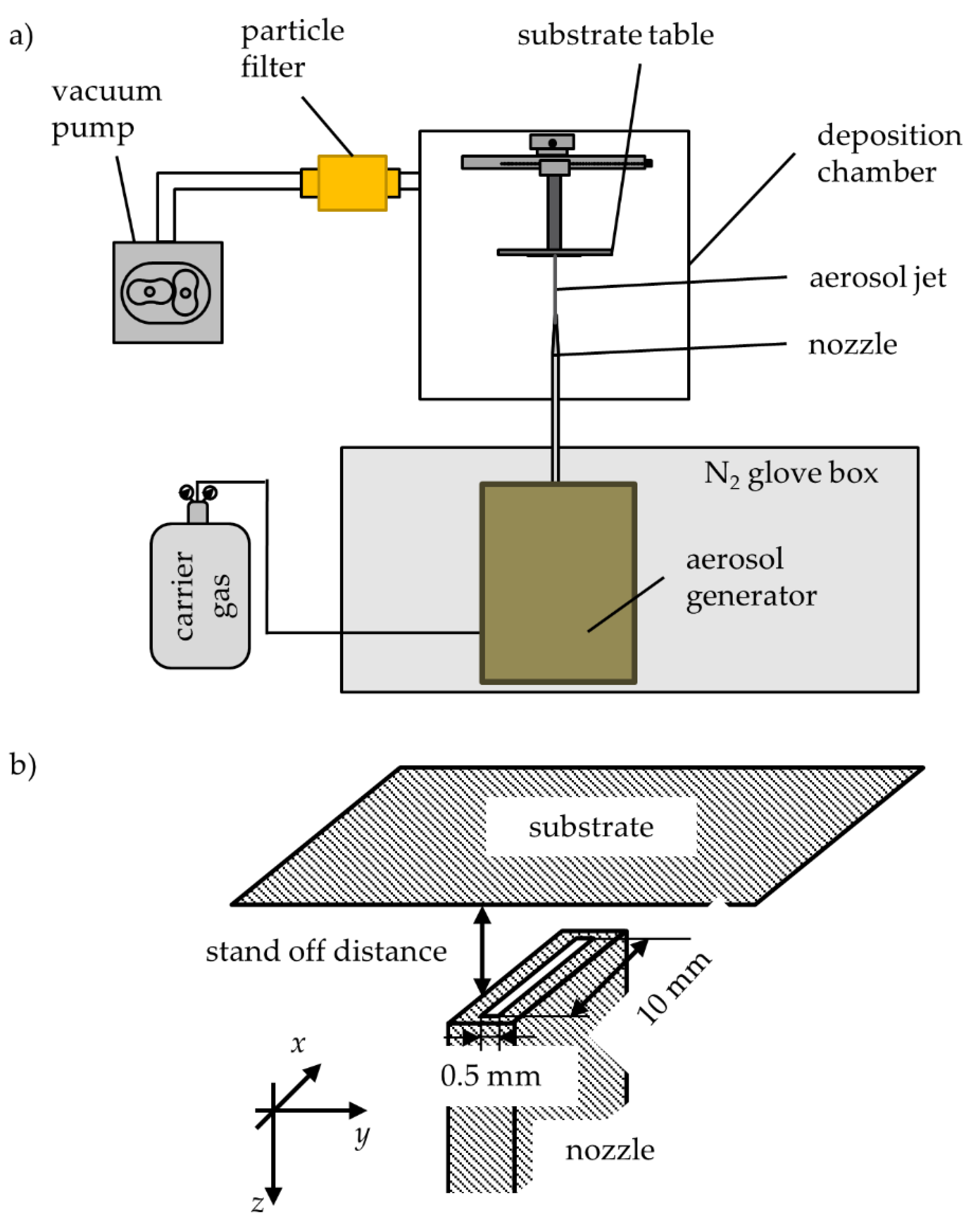
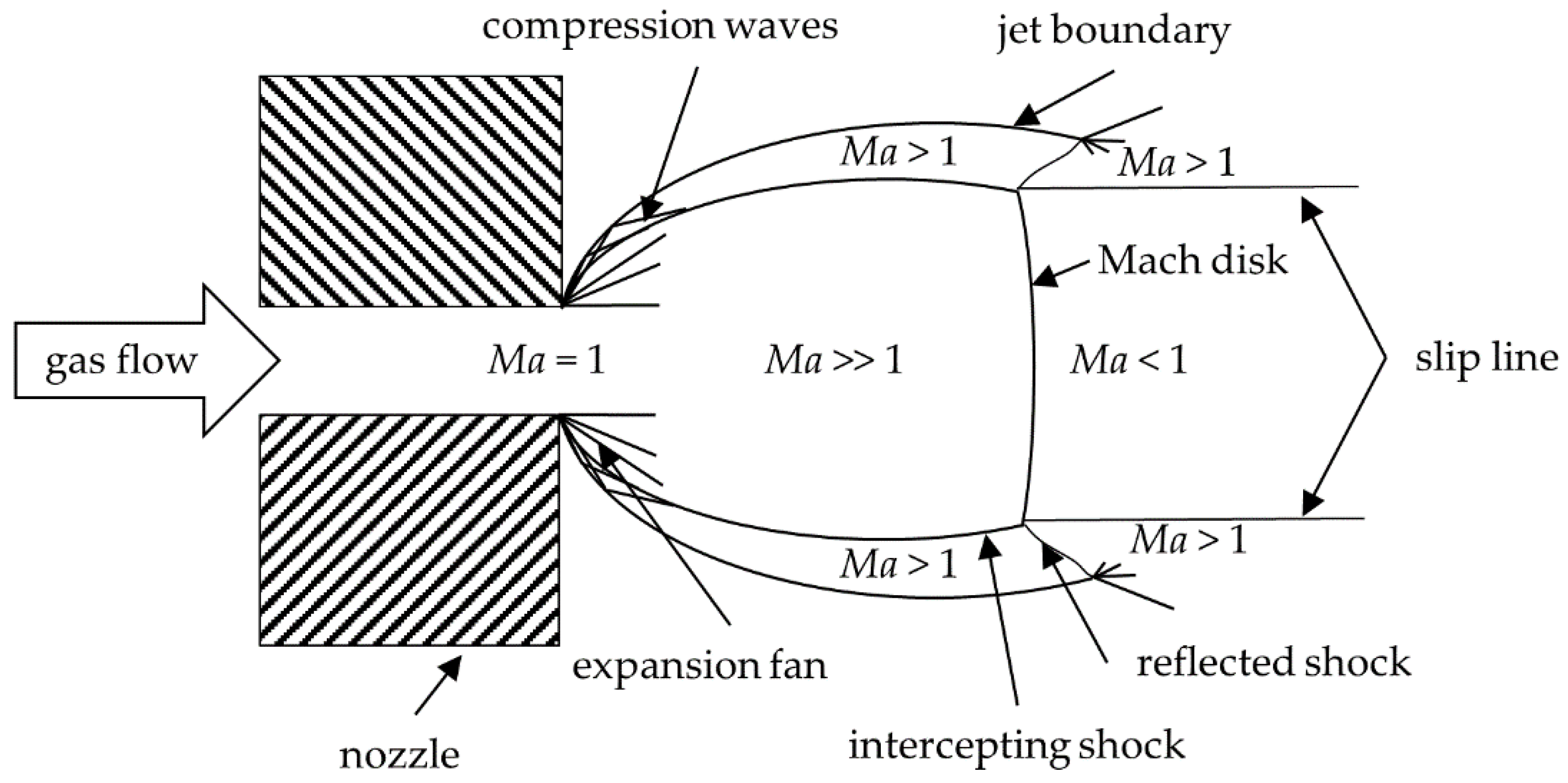

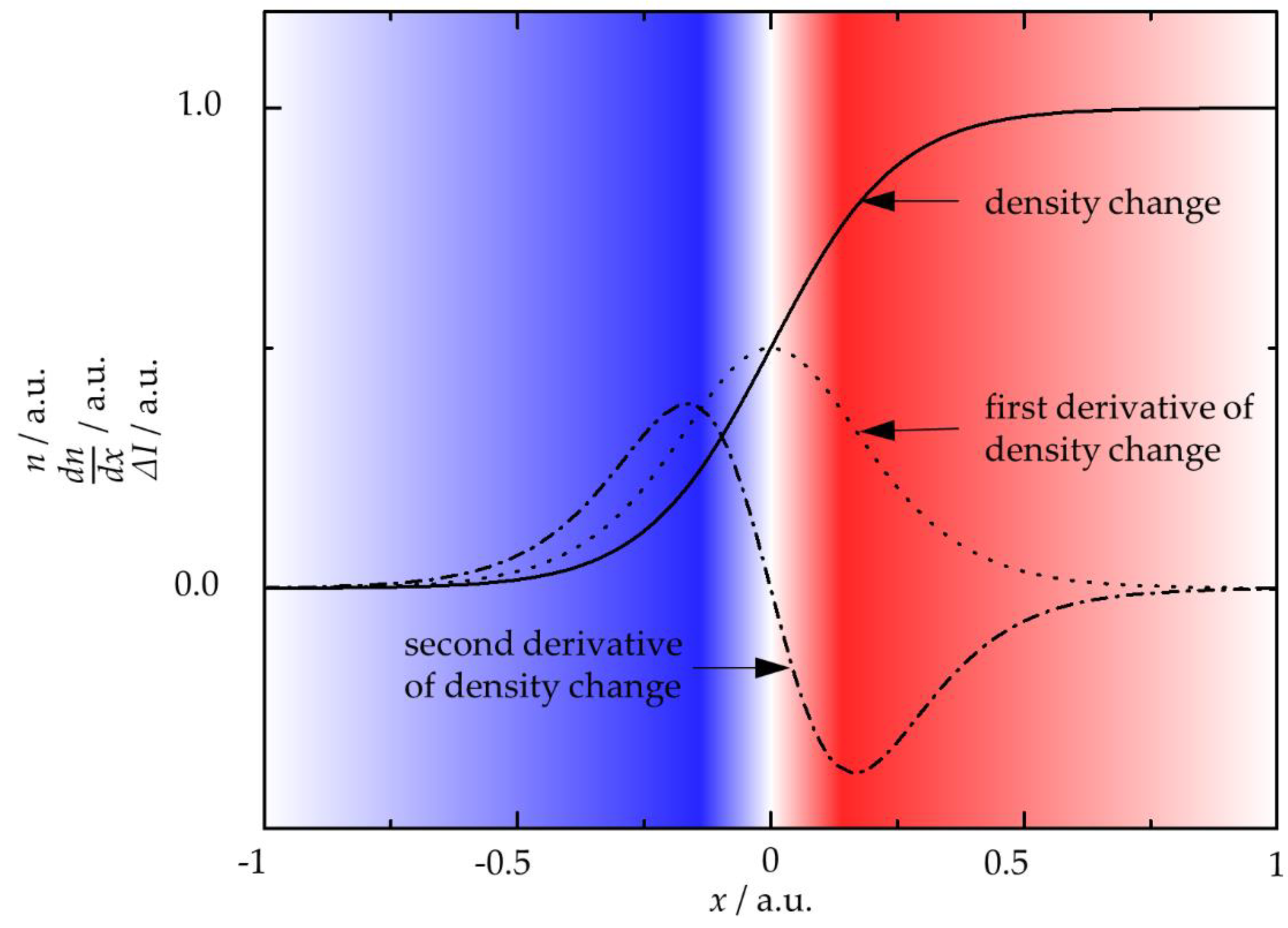
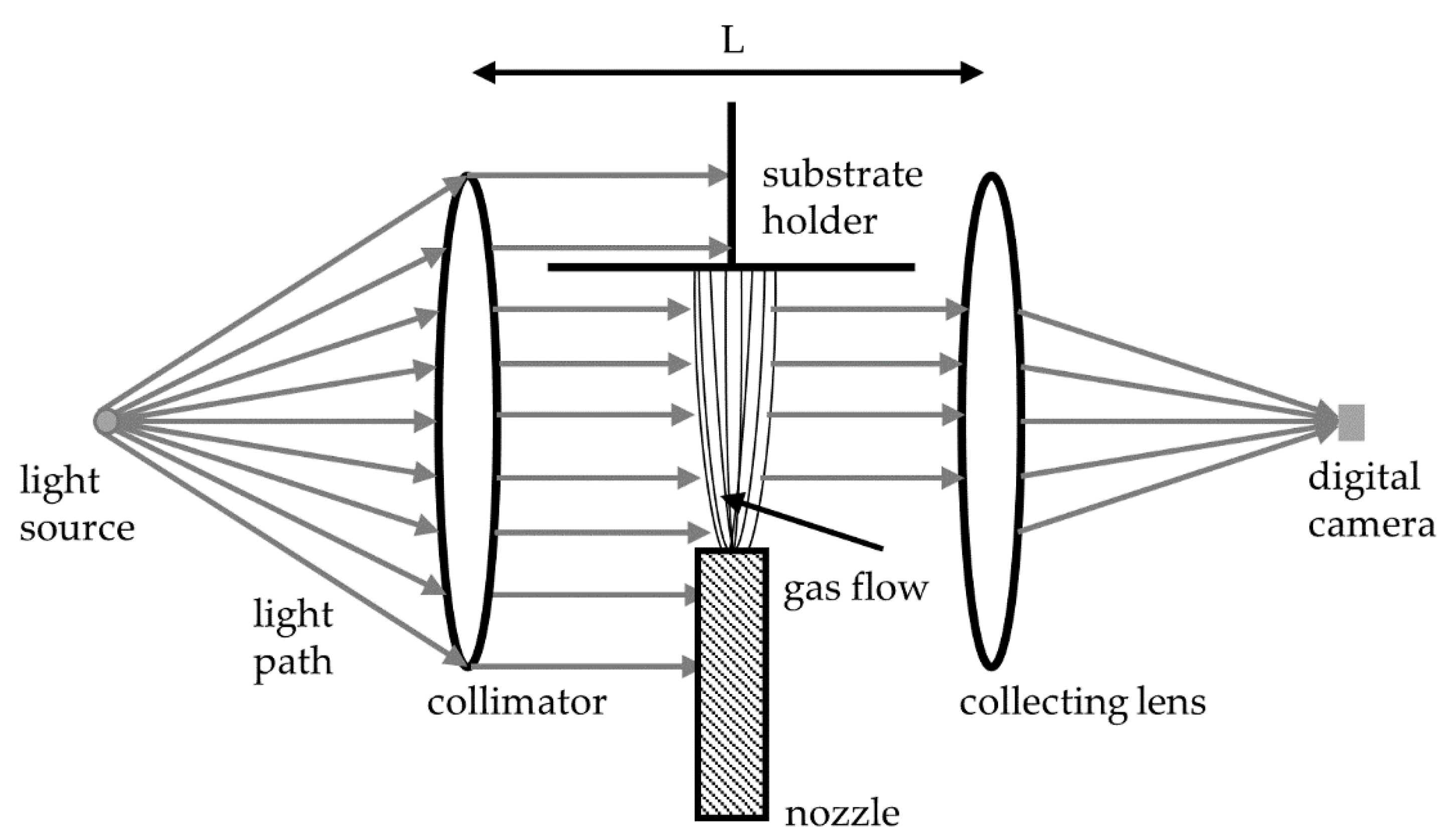
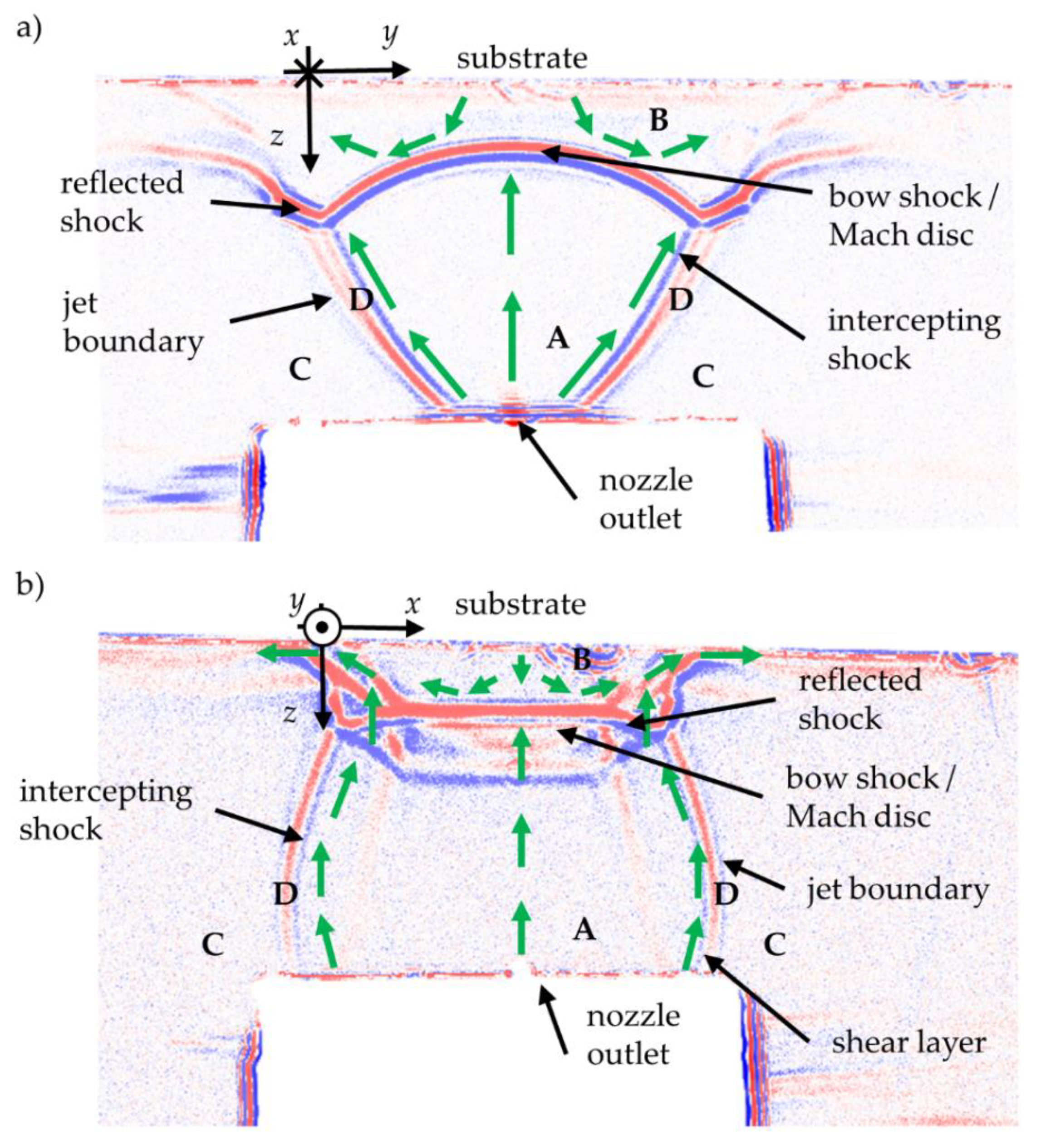
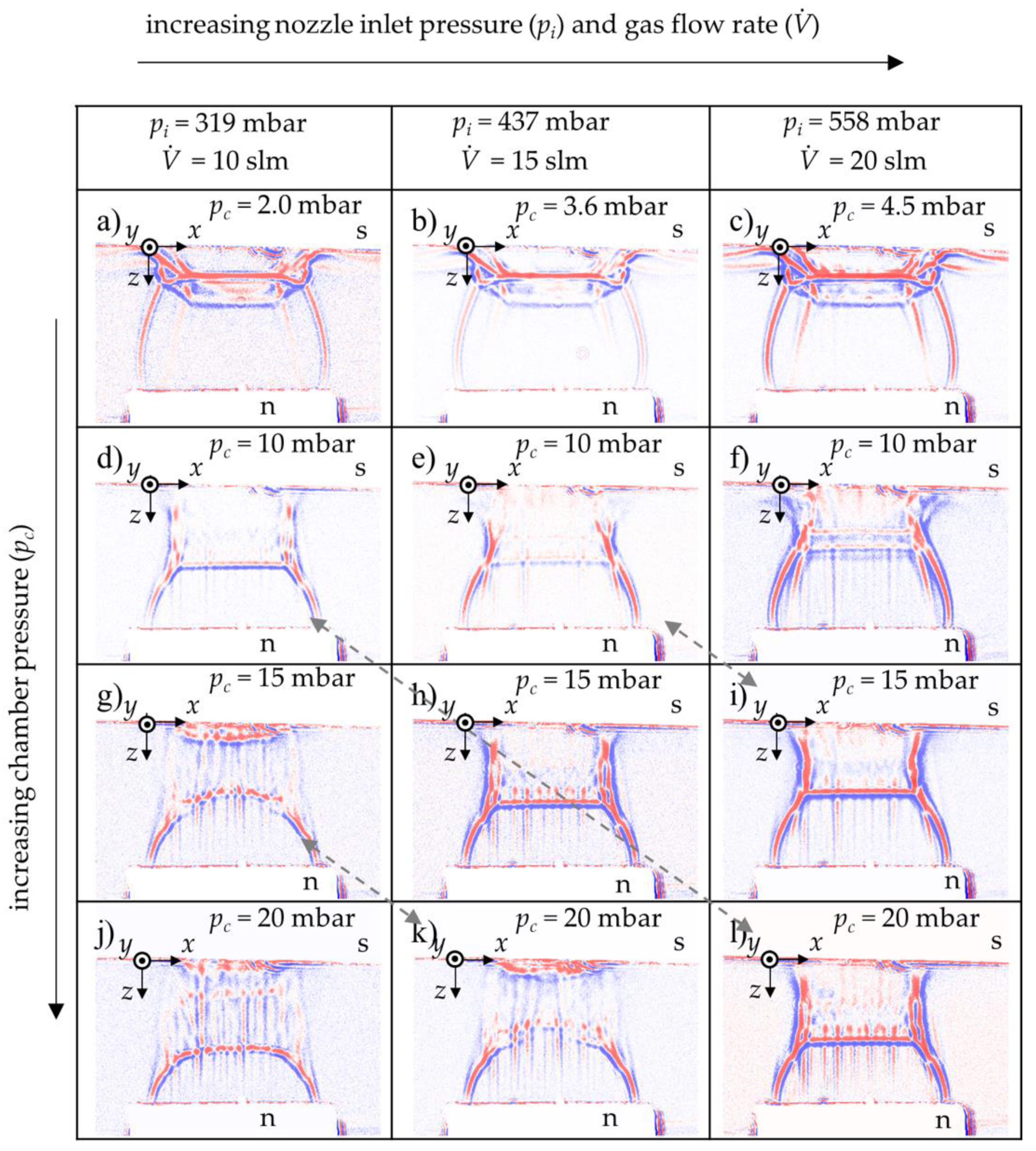
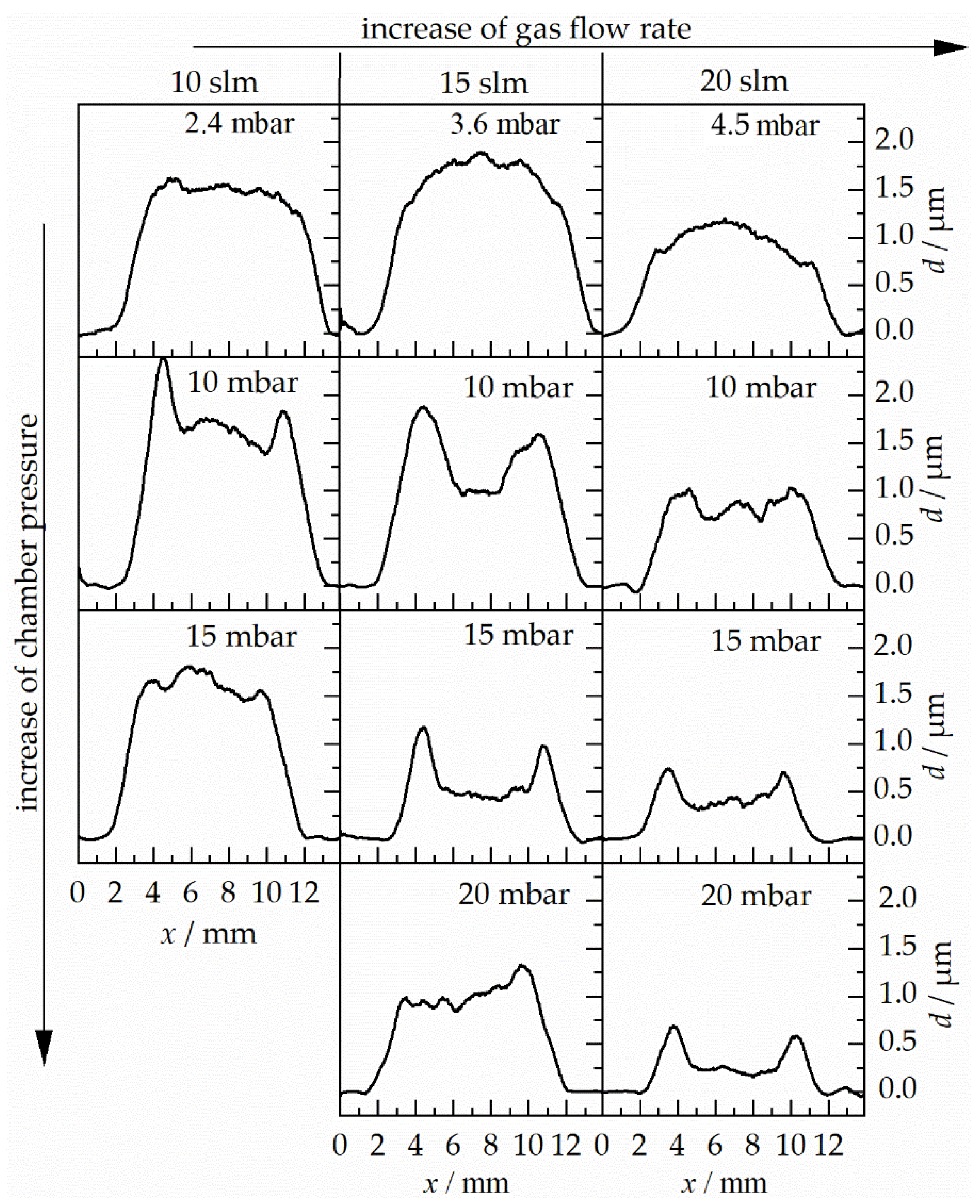
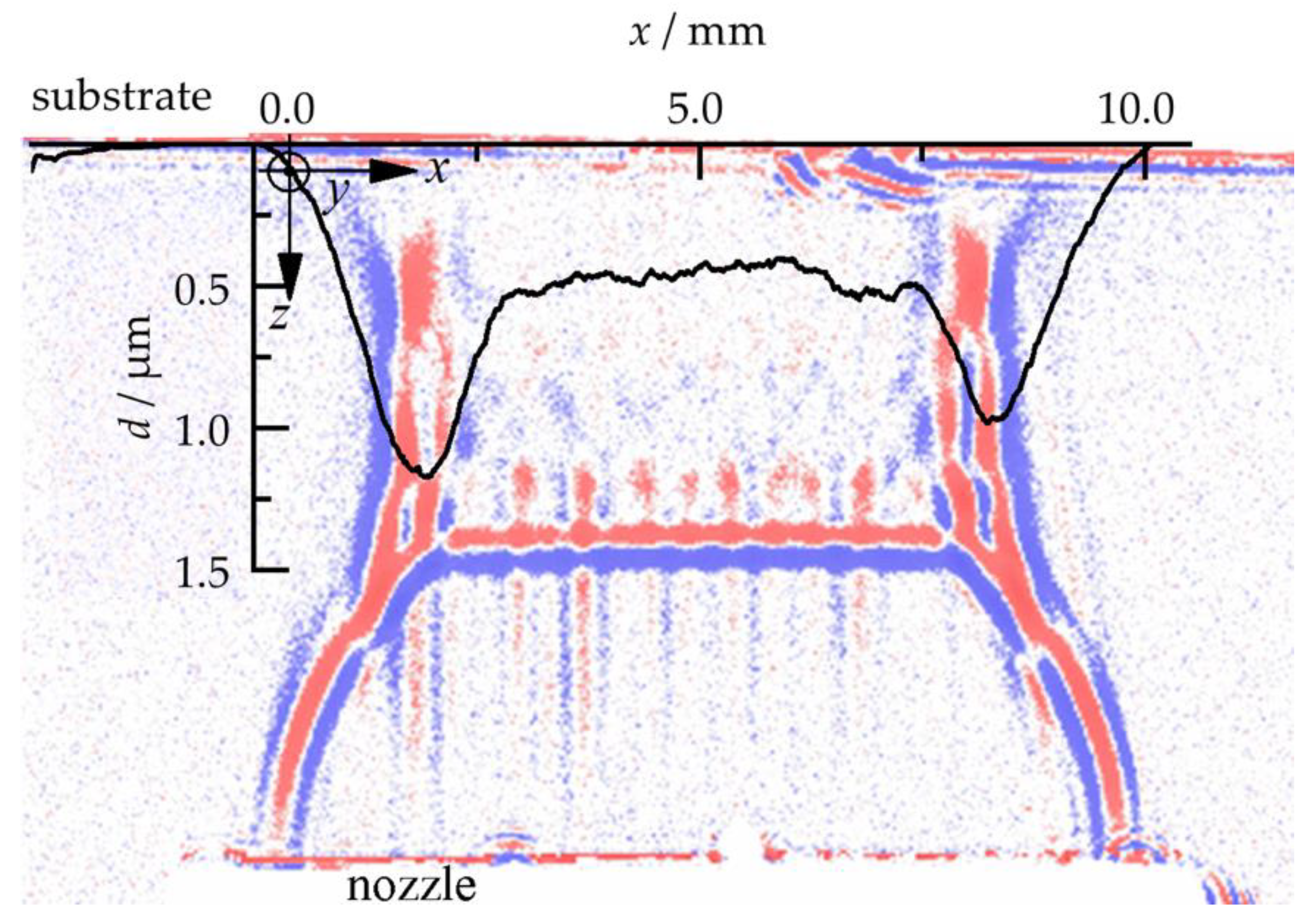
| Gas Flow Rate | Chamber (Back) Pressure/mbar | Number of Scans * |
|---|---|---|
| 10 | 2.6 | 20 |
| 10 | ||
| 15 | ||
| 20 | ||
| 15 | 3.6 | 14 |
| 10 | ||
| 15 | ||
| 20 | ||
| 20 | 4.5 | 10 |
| 10 | ||
| 15 | ||
| 20 |
Publisher’s Note: MDPI stays neutral with regard to jurisdictional claims in published maps and institutional affiliations. |
© 2021 by the authors. Licensee MDPI, Basel, Switzerland. This article is an open access article distributed under the terms and conditions of the Creative Commons Attribution (CC BY) license (https://creativecommons.org/licenses/by/4.0/).
Share and Cite
Glosse, P.; Denneler, S.; Stier, O.; Moos, R. Investigation of the Powder Aerosol Deposition Method Using Shadowgraph Imaging. Materials 2021, 14, 2502. https://doi.org/10.3390/ma14102502
Glosse P, Denneler S, Stier O, Moos R. Investigation of the Powder Aerosol Deposition Method Using Shadowgraph Imaging. Materials. 2021; 14(10):2502. https://doi.org/10.3390/ma14102502
Chicago/Turabian StyleGlosse, Philipp, Stefan Denneler, Oliver Stier, and Ralf Moos. 2021. "Investigation of the Powder Aerosol Deposition Method Using Shadowgraph Imaging" Materials 14, no. 10: 2502. https://doi.org/10.3390/ma14102502
APA StyleGlosse, P., Denneler, S., Stier, O., & Moos, R. (2021). Investigation of the Powder Aerosol Deposition Method Using Shadowgraph Imaging. Materials, 14(10), 2502. https://doi.org/10.3390/ma14102502






